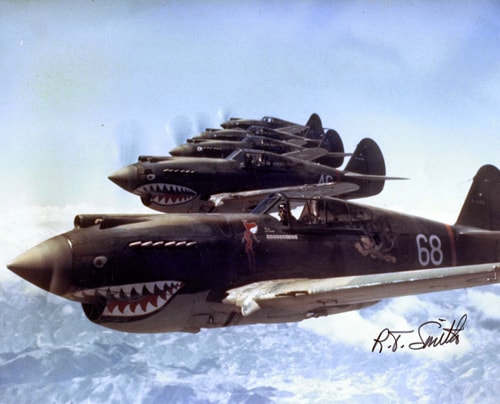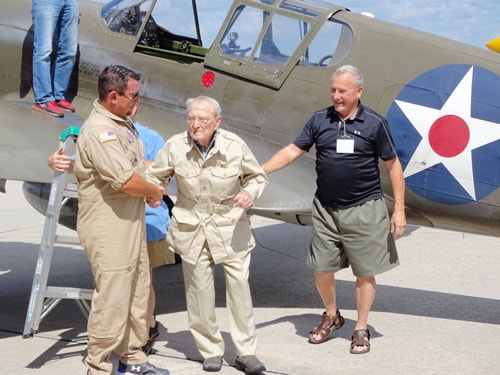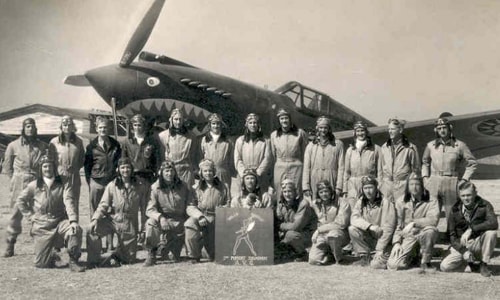American fighter jets once dominated the skies over China.
The Flying Tigers' P-40 fighters terrified Japanese fascist pilots when they fought in the skies over China during World War II.
 |
A squadron of P-40 fighters from the Flying Tigers. Photo: RT Smith |
96-year-old American veteran Frank Losonsky still clearly remembers a day in May 1941, when he was just a 20-year-old soldier, volunteering to board a ship to Asia to join a special force to help China fight against Japanese fascism, which was the famous Flying Tigers team, according to CNN.
Losonsky was one of 311 young Americans recruited into the 1st American Volunteers, which was formed in 1941 and lasted only a year, but wreaked havoc on the Japanese fascists and contributed to the Allied victory in Asia.
The Flying Tigers' weapons were Curtiss P-40 Warhawk fighters, with their noses painted with the image of a baring shark's mouth, which became an icon in the US Air Force and is still inherited today on A-10 attack aircraft.
Starting with 99 P-40 aircraft, the Flying Tigers dominated the skies over China, Thailand, and Myanmar, destroying 297 Japanese fascist fighters in just 7 months of combat, including two pilots achieving Ace status by shooting down 5 enemy aircraft.
Strange Squadron
According to historians, the Flying Tigers were one of the strangest forces in American history. They were volunteers, and under American law, they had to leave the official military before becoming members of the Flying Tigers. That meant that if they were shot down and captured by the Japanese in Asia, they would not be treated as prisoners of war, but could be considered spies and executed.
The men who volunteered to join the Flying Tigers were very different from many other young men of that era. While many tried to avoid the approaching war, they volunteered to go to the most remote and dangerous places.
"I felt like I was doing something. I wasn't scared, I just thought I could contribute something to the country," Losonsky recalled.
The Flying Tigers' operation was classified as a secret operation, "green-lighted" by President Franklin Roosevelt. Volunteers were taken on merchant ships across the Pacific, and they had to use false names to hide their identities.
Losonsky traveled to Asia with a fake passport that listed his occupation as a missionary. Others in the team posed as plantation managers, cowboys, and even circus performers.
Their P-40 fighters were built "like trucks" with a sturdy design that could perform a near-vertical dive to cut off Japanese fighters. This was a tactic invented by the Flying Tigers' commander, "Colonel" Claire Chennault, and became the basis of American piloting techniques in World War II.
 |
Mr. Losonsky (center) stands next to a P-40 fighter plane. Photo: CNN |
Chennault was also a strange officer in the US military. Although he was an air force major, he always called himself "colonel", and was always at odds with his superiors. While the US air force leaders favored the doctrine of using bombers to attack the enemy, he firmly supported the use of fighters to pursue the enemy.
However, to the members of the Flying Tigers, he was a great commander, brave and exemplary. With his P-40, he sought to overcome the superior maneuverability and speed of the Japanese Zero fighter, using interception tactics, diving from above, using superior firepower to suppress the enemy, and diving to avoid being pursued.
This fighting style was so effective that Japanese pilots had to call the Flying Tigers "ruffians" because they thought the American pilots fought "unfairly".
Confrontation
 |
Members of a company of the Flying Tigers unit stationed in Kunming. Photo: CNN |
Chennault divided the Flying Tigers into three companies, each with 33 aircraft, pilots, and ground crews. They underwent intensive combat training in Burma, then deployed to Kunming, China, in late 1941. During the arduous training, they lost several aircraft and three pilots, and some became discouraged and left the group and returned to the United States.
The Flying Tigers were placed on high combat alert after the Japanese attack on Pearl Harbor on December 7, 1941. More than a week later, two of their companies flew their first sortie, shooting down six Japanese bombers en route to bomb Kunming.
On December 23, 1941, the 1st Company of the Flying Tigers encountered a powerful force of 60 Japanese bombers and 30 fighters in the skies over Burma. 14 P-40s took off and, after a fierce dogfight, destroyed a total of 35 Japanese aircraft and damaged many others. The Flying Tigers lost only 5 P-40s and two pilots.
Video simulating the encounter with Japanese aircraft of the 1st Flying Tigers Company:
Such fierce battles took place more and more frequently in the skies over Burma and China until July 1942. The Chinese press and people praised this force, which they called "Flying Tigers", as they witnessed hundreds of Japanese planes being shot down by American fighters.
In the United States, doubts about the Flying Tigers' fighting ability among military officials disappeared, and Chennault was gradually praised as a hero for his tactical ability. Military experts believe that it was the Flying Tigers that held the Japanese back in China, creating a strategic advantage that gave the United States time to prepare its forces, build tanks, planes and other weapons for the crucial confrontation with the Japanese fascists.
By July 1942, when the United States officially declared war on Japan, the secret mission of the Flying Tigers ended, leaving the battlefield to the US Air Force. A total of 23 Flying Tiger pilots and technicians were killed or went missing in action.
The Flying Tigers were disbanded, and most of the pilots returned to the United States to continue their normal lives. Losonsky became a passenger pilot, but stories about this special force continued to spread and became more and more famous.
To date, only three members of the Flying Tigers remain alive: Losonsky, ordnanceman Charles Baisden, and the last pilot, Carl Brown. They are rare living witnesses to one of the strangest stories of World War II.
According to VNE
| RELATED NEWS |
|---|
